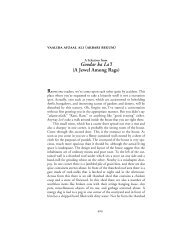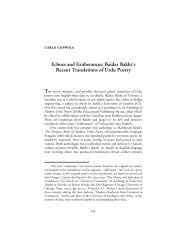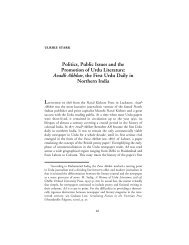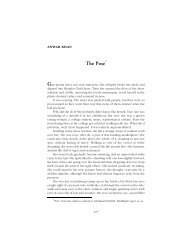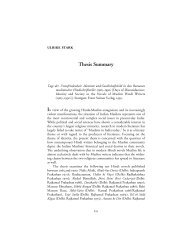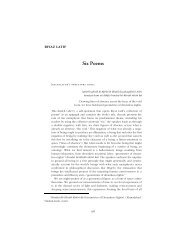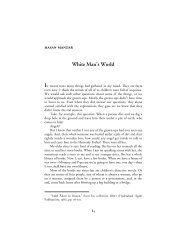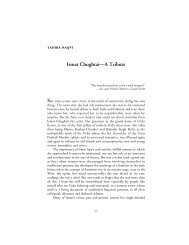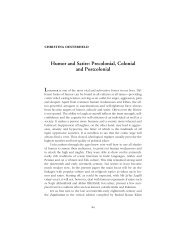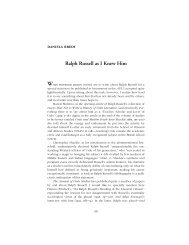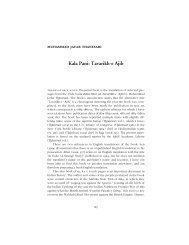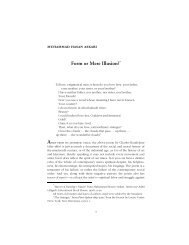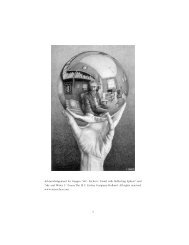Delhi College and Urdu* - MINDS@UW Home
Delhi College and Urdu* - MINDS@UW Home
Delhi College and Urdu* - MINDS@UW Home
You also want an ePaper? Increase the reach of your titles
YUMPU automatically turns print PDFs into web optimized ePapers that Google loves.
132 • THE ANNUAL OF URDU STUDIEStransmission of knowledge in print occurred, in part, thanks to personalitiesassociated with <strong>Delhi</strong> <strong>College</strong> directly or indirectly. Sir Sayyid AhmadKhan, the founder of Aligarh <strong>College</strong>, is sometimes erroneously namedamong the graduates of <strong>Delhi</strong> <strong>College</strong>, perhaps because his first schemefor Aligarh was patterned after the two sections, <strong>and</strong> the Urdu medium,of the <strong>Delhi</strong> institution. He did not study there but did collaborate withMaulavµ Im≥m Bakhsh, Persian teacher at the college, on a study of thetopography of <strong>Delhi</strong>, ¥¡≥ru ’Ω-¿an≥dµd, which remains a leading source onthe condition of the old city before much of it was destroyed during <strong>and</strong>after the 1857 revolt. 35 Maul≥n≥ Maml∑k ‘Alµ N≥nautavµ, Arabic teacher atthe college, had among his students <strong>and</strong> descendants scholars who eventuallyfounded the madrasa at Deob<strong>and</strong>. 36 <strong>Delhi</strong> <strong>College</strong> was thus, in nosmall measure, the precursor of the two supposedly opposing centers ofIndo-Muslim cultural revival <strong>and</strong> reform in the late nineteenth century:Aligarh <strong>and</strong> Deob<strong>and</strong>.The role of the college in the literary life of the Mughal capital wassignificant. The relationship of Muftµ ¿adru ’d-Dµn ¥zurda to the localcollege committee has already been noted. The Muftµ took part inexamining advanced students in Urdu <strong>and</strong> Persian, <strong>and</strong> the more skilledamong them gained access to his literary salon. The college press <strong>and</strong> itspublications were respected in the city. Maulvµ Mu√ammad B≥qir, founderin 1836 of one of the first Urdu newspapers in <strong>Delhi</strong>, the Dehlµ Urd∑Akhb≥r, printed a number of the Vernacular Society’s translations in hispress <strong>and</strong> sent his son, Mu√ammad ƒusain ¥z≥d, to the college. 37 MohanLal Kashmiri, who studied surveying at the college <strong>and</strong> was one of its firstgraduates, accompanied Burnes to Bukhara <strong>and</strong> contributed to theaccounts of those explorations. Other graduates of the college includedMaulvµ Naÿµr A√mad (1833–1912), whose father sent him from Bijnor to<strong>Delhi</strong> to study traditional Islamic sciences. When Naÿµr A√mad wasoffered a stipend at <strong>Delhi</strong> <strong>College</strong>, his father agreed, on one condition:that he would not learn English. He did so only later in life, became aDeputy Collector in the British administration, <strong>and</strong> helped translate theCriminal Code into Urdu. He is best known as the author of numerous35 Christian W. Troll, “A Note on an Early Topographical Work of SayyidAhmad Khan: Asar al-Sanadid,” JRAS (1972), 135–46.36 Barbara Metcalf, Islamic Revival in British India, pp. 74–5.37 MDK, pp. 159–79; David Lelyveld, Aligarh’s First Generation (Princeton:Princeton University Press, 1978), pp. 124–8.



